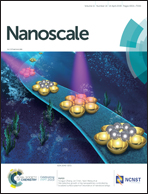Drying of electrically conductive hybrid polymer–gold nanorods studied with in situ microbeam GISAXS†
Abstract
Gold nanorods (AuNRs) with conductive polymer shells are interesting colloidal building blocks for electronics. Hybrid particles with AuNR cores and poly(3,4-ethylenedioxythiophene) or polystyrene sulfonate (PEDOT:PSS) shells were prepared as stable aqueous dispersions. Film formation during the drying of such dispersions is known to affect the electric conductivity of the material. We observed the mechanisms of drying in thin, spray-coated films with grazing incidence small-angle X-ray scattering (GISAXS). A sparse, uniform monolayer formed because the anisotropic shape of the AuNR inhibited “coffee-ring” effects. We used generalized two-dimensional correlation (2DC) spectroscopy to analyze the GISAXS data and to decipher the microscopic structure formation of the film during drying. Four major scattering peaks were attributed to porous PEDOT, PSS, Au, and the substrate layer. Their time-dependent intensity indicated the sequence of film formation: AuNRs with mobile shells arranged on the substrate first, and PEDOT and then PSS dried sequentially around the gold core. We discuss the final phase-separation of PEDOT:PSS on the hybrid rods.



 Please wait while we load your content...
Please wait while we load your content...